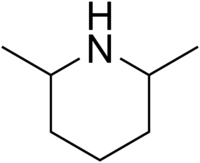2,6-Dimethylpiperidine
 | |
| Names | |
|---|---|
| Preferred IUPAC name
2,6-Dimethylpiperidine | |
| Other names
2,6-Lupetidine | |
| Identifiers | |
| 766-17-6 | |
| 3D model (Jmol) | Interactive image Interactive image |
| ChemSpider | 62076 |
| ECHA InfoCard | 100.110.974 |
| RTECS number | OK5775000 |
| |
| |
| Properties | |
| C7H15N | |
| Molar mass | 113.20 g·mol−1 |
| Appearance | Colorless liquid |
| Density | 0.84 g/mL |
| Boiling point | 113.2 °C (235.8 °F; 386.3 K) |
| Low | |
| Solubility in other solvents | Most organic solvents |
| Basicity (pKb) | ca. 10 |
| Refractive index (nD) |
1.4394 |
| Hazards | |
| Main hazards | Flammable |
| R-phrases | R11-R36/37/38 |
| S-phrases | S16-S26 |
| Flash point | 11 °C (52 °F; 284 K) |
| Related compounds | |
| Related compounds |
Piperidine |
| Except where otherwise noted, data are given for materials in their standard state (at 25 °C [77 °F], 100 kPa). | |
| | |
| Infobox references | |
2,6-Dimethylpiperidines are chemical compounds with the formula C5H8(CH3)2NH. Three stereoisomers exist: the achiral (R,S)-isomer and the chiral (R,R)/(S,S) enantiomeric pair. Dimethylpiperidines are derivatives of the heterocycle piperidine, wherein two hydrogen atoms are replaced by methyl groups.
The 2,6-dimethylpiperidines are prepared by reduction of 2,6-dimethylpyridine (2,6-lutidine). The achiral isomer is the predominant isomer produced in this reaction.
The 2,6-dimethylpiperidines are of interest for their conformational properties. The (R,S)-isomer exists largely in the chair conformation with equatorial methyl groups. The (R,R)/(S,S)-isomers are attractive chiral secondary amine building blocks.[1]
References
This article is issued from Wikipedia - version of the 9/18/2016. The text is available under the Creative Commons Attribution/Share Alike but additional terms may apply for the media files.